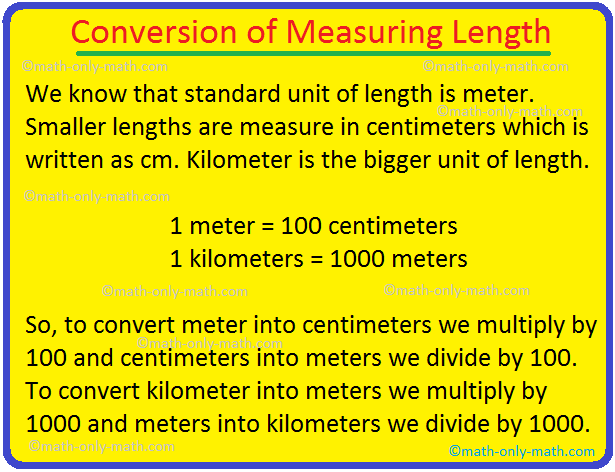Subscribe to our ▶️ YouTube channel 🔴 for the latest videos, updates, and tips.
Conversion of Measuring Length
In conversion of measuring length we will learn how to convert meters into centimeters, kilometers into meters, centimeters into meters and meters into kilometers.
We know that standard unit of length is meter. Smaller lengths are measure in centimeters which is written as cm. Kilometer is the bigger unit of length.
1 meter = 100 centimeters
1 kilometers = 1000 meters
So, to convert meter into centimeters we multiply by 100 and centimeters into meters we divide by 100. To convert kilometer into meters we multiply by 1000 and meters into kilometers we divide by 1000.
To convert meters into centimeters, multiply the number of meters by 100.
(i) 1 m = 100 cm
(ii) 2 m = 2 × 100 cm = 200 cm
(iii) 3 m = 3 × 100 cm = 300 cm
(iv) 5 m = 5 × 100 cm = 500 cm
To convert kilometers into meters, multiply the number of kilometers by 1000.
(i) 1 km = 1000 m
(ii) 2 km = 2 × 1000 m = 2000 m
(iii) 3 km = 3 × 1000 m = 3000 m
7 km = 7 × 1000 m = 7000 m
To convert centimeters into meters, divide the number of centimeters by 100 or put a fot (.) after 2 digits from right.
|
(i) 100 cm = 1.00 m or 1 m (ii) 200 cm = 2.00 m or 2 m
(iv) 800 cm = 8.00 m or 8 m (v) 1100 cm = 11.00 m or 11 m |
100 cm = 100 ÷ 100 = 1 m 200 cm = 200 ÷ 100 = 2 m
800 cm = 800 ÷ 100 = 8 m 1100 cm = 1100 ÷ 100 = 11 m |
To convert meters into kilometers, divide the number of meters by 1000 or put a dot (.) after 3 digits from right.
(i) 1000 m = 1000 ÷ 100 = 1 km or 1.000 km
(ii) 2000 m = 2000 ÷ 100 = 2 km or 2.000 km
(iii) 3000 m = 3000 ÷ 100 = 3 km or 3.000 km
(iv) 9000 m = 9000 ÷ 100 = 9 km or 9.000 km
Solved Examples on Conversion of Measuring Length:
I. Convert meters into kilometers.
1. Convert 9000 m into km.
Solution:
We know that,
1 m = \(\frac{1}{1000}\) km
Therefore, 9000 m = \(\frac{1}{1000}\) × 9000 km = \(\frac{9000}{1000}\) km = 9 km.
Answer: 9000 m = 9 km.
II. Convert meters centimeters into centimeters.
1. Convert 23 m 40 cm into cm
Solution:
23 m 40 cm
= 23 m + 40 cm
= (23 × 100) cm + 40 cm; [Since, we know that 1 m = 100 cm]
= 2300 cm + 40 cm
= 2340 cm
Answer: 23 m 40 cm = 2340 cm.
III. Convert kilometers meters into meters.
1. Convert 26 km 50 m into m
Solution:
26 km 50 m = 26 km + 50 m
= (26 x 1000) m + 50 m; [Since, 1 km = 1000 m]
= 26000 m + 50 m
= 26050 m
Answer: 26 km 50 m = 26050 m.
IV. Convert centimeters into meters and centimeters.
1. Convert 425 cm into m and cm.
Solution:
425 cm
= 400 cm + 25 cm
= 4 m + 25 cm; [Since, 100 cm = 1 m ]
= 4 m 25 cm
Answer: 425 cm = 4 m 25 cm.
V. Convert millimeters into meters and centimeters.
1. 9250 mm into m and cm
Solution:
9250 mm = 9000 mm + 250 mm
= 9 m + 25 cm; [Since, 1000 mm = 1 m and 10 mm = 1 cm]
= 9 m 25 cm
Answer: 9250 mm = 9 m 25 cm.
Worksheet on Conversion of Measuring Length:
1. Convert into km:
(i) 1009 m = __________ km
(ii) 4292 m = __________ km
(iii) 1725 m = __________ km
Answer:
1. (i) 1.009 km
(ii) 4.292 km
(iii) 1.725 km
Measurement of Length:
Conversion of Standard Unit of Length
Addition and Subtraction of Measuring Length
Addition and Subtraction of Measuring Mass
Addition and Subtraction of Measuring Capacity
From Conversion of Measuring Length to HOME PAGE
Didn't find what you were looking for? Or want to know more information about Math Only Math. Use this Google Search to find what you need.



New! Comments
Have your say about what you just read! Leave me a comment in the box below. Ask a Question or Answer a Question.